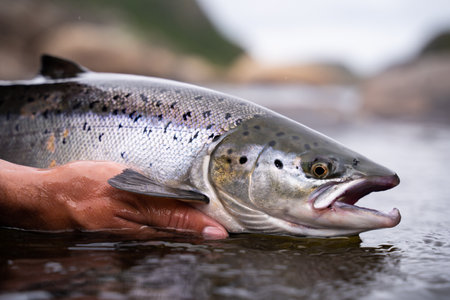1. Essential Fall Musky Rods
When it comes to fall musky fishing across American lakes and rivers, choosing the right rod can make or break your day on the water. As muskies become more aggressive during the late season, youll need gear that delivers both power and precision.
Choosing the Right Rod for Fall Musky Fishing
There are three key things to consider when picking a musky rod for fall: length, power, and action. Here’s how they stack up:
| Rod Length | Power | Action | Best For |
|---|---|---|---|
| 76″ – 86″ | Heavy – Extra Heavy | Fast | Long casts, big baits, handling trophy muskies |
| 70″ – 76″ | Medium Heavy – Heavy | Moderate Fast | Tight spots, casting accuracy, medium-size lures |
| 86″ – 90″+ | Extra Heavy | Fast/Extra Fast | Figure 8s at the boat, deep water retrieves, oversized baits |
Why Rod Length Matters in Fall
Longer rods (over 8 feet) are popular for fall musky because they help you cast heavier baits farther and work larger figure-8s right at the boat. This is crucial for triggering follows into strikes when muskies get stubborn in cold water.
Power: Go Heavy or Go Home
Muskies in the fall are chasing bigger meals, so you’ll likely be throwing large rubber baits, jerkbaits, and massive bucktails. A heavy or extra-heavy rod ensures you have enough backbone to set hooks hard and control big fish when it counts.
The Importance of Fast Action Tips
A fast or extra-fast action tip gives you sensitivity for feeling subtle bites but still provides plenty of muscle for driving hooks home. This combination is ideal for both casting accuracy and solid hooksets—key factors when targeting monster fall muskies.
2. Reliable Musky Reels for Big Hits
When you’re chasing monster muskies in the fall, your reel is your workhorse. A good musky reel lets you muscle in big fish, rip heavy baits, and withstand hours of casting without missing a beat. Let’s break down what makes a musky reel reliable when those cold-front giants are on the move.
Popular Reel Styles for Musky Fishing
Musky anglers in the U.S. typically reach for two main reel styles: baitcasting and spinning. Each has its place, but baitcasters dominate because they handle heavier lines and bigger lures with ease.
| Reel Style | Best For | Why Use It? |
|---|---|---|
| Baitcasting | Big lures, heavy lines, long casts | Strong drag systems and more torque for fighting trophy muskies |
| Spinning | Lighter presentations, beginners | Easier to use but less power for big baits or fish |
Key Gear Ratios for Fall Muskies
Gear ratio tells you how fast your reel picks up line. In fall, you’ll want something that matches your fishing style:
- Fast (6.3:1 and up): Burn bucktails or cover water quickly.
- Medium (5.1:1–6.2:1): Great all-around choice for most fall tactics.
- Slow (below 5.0:1): Ideal for deep cranking or working big rubber baits slow and steady.
Typical Gear Ratios and Best Uses Table
| Gear Ratio | Main Use in Fall Musky Fishing | Example Bait Types |
|---|---|---|
| 7.1:1+ | Burning bucktails, fast retrieves | Bucktails, topwaters |
| 5.3:1–6.2:1 | Versatile, balanced power & speed | Cranbaits, jerkbaits, gliders |
| <5.0:1 | Big rubber baits, deep presentations | Bull Dawgs, Medusas, Magnums |
Durability Factors That Matter on the Water
Muskies are known as “the fish of 10,000 casts” for a reason—you’ll need a reel built to last. Here’s what to look for:
- Solid Frame: Aluminum frames hold up best under pressure and repeated use.
- Tough Gears: Brass or stainless steel gears stand up to big hits and heavy lures.
- Smooth Drag: Carbon fiber drag washers give consistent pressure without stutter—even when a trophy peels off line at boatside.
- Bearing Count: More isn’t always better, but quality sealed bearings keep things smooth after hundreds of casts in tough conditions.
- Easily Serviced: Look for reels with accessible side plates so you can clean and grease them easily during your season.
If you match your reel’s style, gear ratio, and durability to your preferred fall tactics, you’ll be ready for those jaw-dropping musky strikes when the leaves start to drop.
![]()
3. Must-Have Power Tackle
If you’re heading out for fall musky fishing, you’ll need more than just the right rod and reel. Muskies get fired up in autumn, so your power tackle needs to match their aggressive strikes. Here’s a checklist of the essential lures, leaders, and heavy line every musky hunter should pack.
Lures That Trigger Fall Strikes
Muskies in the fall are chasing bigger prey and hitting harder. Stock up on these proven lure types to cover all your bases:
| Lure Type | Best Use | Top Color Choices |
|---|---|---|
| Bucktails | Burning over weed beds & open water | Black/Nickel, Firetiger, Chartreuse |
| Large Crankbaits | Trolling or casting along drop-offs | Walleye, Perch, Shad patterns |
| Jerkbaits/Glide Baits | Working structure & rock piles | Cisco, Sucker, Natural hues |
| Rubber Swimbaits | Slow rolling deep breaks | White, Black/Orange tail, Green Pumpkin |
| Topwater Lures | Dawn/dusk surface action | Bullfrog, Black, Silver |
Heavy-Duty Leaders: No Weak Links Allowed
A toothy musky can slice regular line like butter. For serious fall fishing, always rig up with a quality leader. Here’s what to look for:
- Fluorocarbon Leaders (80-130 lb): Stealthy and abrasion-resistant for clear water.
- Wire Leaders (90-150 lb): Essential for heavy cover or when muskies are slashing at baits.
- Ball Bearing Swivels: Prevents line twist and adds extra strength on big hooksets.
Packing the Right Line for Power Fishing
Your mainline needs to handle monster fish and tough cover. Don’t skimp here—fall is no time for light tackle.
| Line Type | Pound Test Range | Main Benefits |
|---|---|---|
| Braided Line | 80-100 lb+ | No stretch, solid hooksets, slices through weeds easily. |
| Mono/Co-Polymer Backup | 50-80 lb | Smooth casts; use as backing under braid on big reels. |
Tackle Checklist Before You Hit the Water:
- Bucktails, crankbaits, jerkbaits, rubber swimbaits, topwater lures (multiple sizes/colors)
- Fluorocarbon and wire leaders (pre-rigged if possible)
- Braided line (at least 80 lb), with mono/copolymer backup spool(s)
- Pliers and jaw spreaders for safe unhooking—don’t forget!
- Tough landing net rated for big muskies—these fish mean business in the fall!
If you check off everything above, you’ll be ready for those aggressive autumn musky hits. Make sure your gear is dialed in—you never know when that trophy will smash your bait!
4. Cold-Weather Clothing and Safety
Chasing big muskies in the fall means dealing with dropping temps, biting wind, and sometimes surprise rain or sleet. The right clothing and safety gear can make or break your trip. Here’s a practical breakdown of what you’ll need to stay warm, dry, and safe on the water.
Recommended Clothing for Fall Musky Fishing
| Layer | What to Wear | Purpose |
|---|---|---|
| Base Layer | Moisture-wicking thermal shirt and pants (synthetic or merino wool) | Keeps sweat off your skin and retains warmth |
| Mid Layer | Insulating fleece or softshell jacket | Adds warmth without bulk, easy to move in |
| Outer Layer | Waterproof/breathable rain jacket and bibs (Gore-Tex or similar) | Protects against wind, rain, and spray from the boat |
| Headwear | Warm beanie or insulated cap, neck gaiter/balaclava | Prevents heat loss from your head and neck |
| Gloves | Water-resistant insulated fishing gloves | Keeps hands warm while allowing rod control |
| Footwear | Waterproof boots with thermal socks | Keeps feet dry and insulated on wet decks |
Essential Rain Gear Checklist
- Poncho or Packable Rain Suit: For sudden showers when you need quick coverage.
- Dry Bag: Store extra clothes, phone, wallet, and emergency gear safely.
- Towel: Handy for drying off after a downpour or handling wet fish.
- Boat Blanket: Useful for emergencies if someone gets too cold or soaked.
Straightforward Safety Tips for Fall Fishing Trips
Stay Visible and Connected
- Lifesaving PFD: Always wear a Coast Guard-approved life vest—cold water shock is real.
- Cell Phone/Radio: Waterproof case recommended. Let someone know your float plan before heading out.
- Headlamp/Flashlight: Shorter days mean you may launch or return in low light; keep one handy.
- Chemical Hand Warmers: Slip these into pockets or gloves for extra warmth during long days.
- Sunglasses with Polarized Lenses: Reduces glare off the water even on cloudy days—protects your eyes and helps spot follows.
- Cut-Resistant Gloves: Useful when unhooking toothy muskies in cold conditions to prevent accidents.
- Easily Accessible First Aid Kit: Include bandages, antiseptic wipes, pain relief meds, and any personal medications.
- Buddy System: Whenever possible, fish with a partner—fall conditions can change fast.
Mental Note: Dress in Layers & Check the Weather Often!
The weather can shift quickly on the water in fall. Start with more layers than you think you’ll need—you can always peel one off. Check local forecasts before leaving home, and keep an eye on conditions throughout your trip. Smart preparation keeps you focused on landing that trophy musky instead of shivering through the day!
5. Tackle Box Organization for Quick Swaps
If you’re chasing fall muskies, you know that every second on the water matters—especially when those big fish are hot on your lure. Smart tackle box organization is your secret weapon for fast, hassle-free gear changes. Here’s how to set up your box so you never miss a beat when the action heats up.
Why Efficient Organization Matters
Fall musky fishing means sudden weather changes and aggressive fish that demand quick lure swaps. Fumbling through a messy tackle box wastes time and can cost you bites. By keeping your gear tidy and accessible, you’ll spend more time casting and less time searching.
Must-Have Tackle Box Layouts
| Section | What to Store | Pro Tip |
|---|---|---|
| Lure Slots | Bucktails, jerkbaits, rubber baits (grouped by type and size) | Use foam dividers to prevent hooks from tangling |
| Terminal Tackle Trays | Leaders, snaps, swivels, split rings | Small containers or zip bags keep items separated |
| Tool Compartment | Pliers, hook cutters, jaw spreaders | Magnetic strip keeps tools secure and ready to grab |
| Spare Reel/Line Zone | Extra spools, fluorocarbon/mono leaders | Zip ties or Velcro straps keep spools from unraveling |
| Weather Gear Pocket | Rain gloves, hand warmers, dry cloths | Pocket in the lid or side pouch for quick access |
Quick-Change Strategies When Every Cast Counts
1. Pre-Rig Popular Lures
Tie leaders onto your go-to lures before hitting the water. Keep them in individual slots so you can swap out with a snap and cast again in seconds.
2. Color-Code Your Sections
Add colored stickers or tape to help identify lure types or sizes instantly—no more digging around when you need that specific black-and-orange bucktail.
3. Keep Tools Front and Center
Your pliers and hook cutters should always be within arm’s reach. A dedicated tool tray or magnetic holder on the lid saves precious seconds during a hot bite.
4. Label Everything You Can
A permanent marker works wonders for labeling trays or compartments—especially for small items like split rings or snaps that tend to disappear at the worst moment.
Packing Checklist for Fall Musky Runs:
- Labeled lures sorted by style (bucktails, crankbaits, soft plastics)
- Pre-tied leaders with heavy-duty snaps attached
- Pliers, hook cutters, jaw spreader (all rust-free)
- Extra line & leader material (fluorocarbon or wire)
- Hand warmers & spare gloves stashed for chilly mornings
- A headlamp or flashlight for early dawn or late dusk swaps
- Towel or absorbent cloth for wet hands and gear cleanup
The right tackle box setup keeps your focus where it belongs—on landing that trophy musky this fall! Organize smart, fish hard, and let your gear work as fast as you do.
6. Pro Tips for Fall Musky Success
Insider Strategies to Tackle Tough Fall Conditions
Fall musky fishing can feel like chasing ghosts—one day, they’re hot on your lure; the next, it’s radio silence. But with the right approach and gear, you can tip the odds in your favor. Here are some proven pro tips for wrangling those elusive giants when temps drop and conditions get unpredictable.
Dial in Your Gear—No Shortcuts Allowed
Your rod, reel, and tackle need to match the season. Muskies are aggressive but wary in fall, so every detail counts. Use stout rods with extra backbone (8’-9’ heavy power) and high-capacity reels that handle heavy line. Check out this quick reference:
| Gear Type | Pro Tip |
|---|---|
| Rod | Go longer (8+) for better figure-8s and longer casts. |
| Reel | High-speed baitcasters help burn big baits or slow-roll heavy rubber. |
| Line | 80-100 lb braided line holds up against toothy strikes and dense cover. |
| Leader | Fluorocarbon (130 lb+) or steel to prevent bite-offs. |
Match Your Lures to Fall Patterns
Muskies key in on larger prey as water temps cool. Stock your tackle box with big rubber swimbaits, jerkbaits, and oversized bucktails. Don’t forget deep-diving crankbaits for working breaks and ledges where muskies stage up.
- Rubber baits: Pound Medussas or Bull Dawgs along steep drop-offs.
- Bucktails: Use double 10s or 12s for flash and vibration in stained water.
- Sucker rigs: Live bait shines in late fall—set a quick-strike rig under the boat while casting.
Tweak Your Presentation—Adapt on the Fly
Muskies won’t always chase a fast-moving bait in cold water. Mix up your retrieve speed and pause often to trigger follows into strikes. Master the “figure 8” at the boat side; sometimes that’s when the magic happens.
Top Boat-Side Moves:
- The Figure 8: Wide, smooth turns keep muskies interested after a follow.
- L: Start with a big “L” turn before transitioning into a figure 8 if you spot a shadow behind your bait.
Watch Water Temps & Location Shifts
Muskies move shallower as water cools but hold close to deep structure. Monitor surface temps—when it dips below 55°F, focus on main lake points, weed edges, and break lines where baitfish stack up.
| Water Temp (°F) | Muskie Location |
|---|---|
| >60°F | Main lake flats & weedy bays |
| 55–60°F | Bait-rich break lines & points |
| <55°F | Steep drops & near wintering holes |
Tough Days? Switch It Up!
If what you’re doing isn’t working after an hour or two, change lures, locations, or even downsize your presentation. Sometimes finesse wins when pressure’s high or fronts push through.


